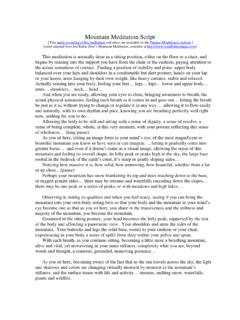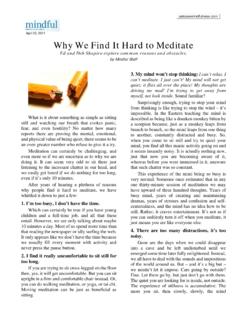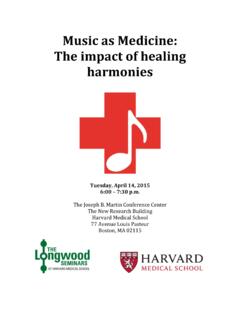Transcription of The Body Scan Meditation
1 |. The body scan Meditation 2005 Jon Kabat-Zinn excerpted from Coming to Our Senses, Hyperion Press, NY, NY [ for audio guidance, go to body scan ] The body scan has proven to be an extremely powerful and healing form of Meditation . It forms the core of the lying down practices that people train in Mindfulness-Based Stress Reduction. It involves systematically sweeping through the body with the mind, bringing an affectionate, openhearted, interested attention to its various regions, customarily starting from the toes of the left foot and then moving through the entirety of the foot to sole, the heel, the top of the foot then up the left leg, including in turn the ankle, the shin and the calf, the knee and the kneecap, the thigh in its entirety, on the surface and deep, the groin and the left hip, then over to the toes of the right foot, the other regions of the foot, then up the right leg in the same manner as the left.
2 From there, the focus moves into, successively, and slowly, the entirety of the pelvic region, including the hips again, the buttocks and the genitals, the lower back, the abdomen, and then the upper torso the upper back, the chest and the ribs, the breasts, the heart and lungs and great vessels housed within the rib cage, the shoulder blades floating on the rib cage in back, all the way up to the collarbones and shoulders. From the shoulders, we move to the arms, often doing them together, starting from the tips of the fingers and thumbs and moving successively through the fingers, the palms, and backs of the hands, the wrists, forearms, elbows, upper arms, armpits, and shoulders again. Then we move in to the neck and throat, and finally, the face and When we practice the body scan , we are systematically and intentionally moving our attention through the body , attending to the various sensations in the different regions.
3 That we can attend to these body sensations at all is quite remarkable. That we can do it at will, either impulsively or in a more disciplined systematic way, is even more so. Without moving a muscle, we can put our mind anywhere in the body we choose and feel and be aware of whatever sensations are present in that moment. Experientially, we might describe what we are doing during a body scan as tuning in or opening to those sensations, allowing ourselves to become aware of what is already unfolding, much of which we usually tune out because it is so obvious, so mundane, so familiar that we hardly know it is there, I mean here. And of course, by the same token we could say that most of the time in our lives we hardly know we are there, I mean here, experiencing the body , in the body , of the body .. the words actually fail the essence of the experience.
4 When we speak about it, as we ve already observed, language itself forces us to speak of a separate I who has a body . We wind up sounding hopelessly dualistic. And yet, in a way there certainly is a separate I who has a body , or at least, there is a very strong appearance of that being the case, and we have spoken of this as being the level of conventional reality, the relative, the level of appearances. In the domain of relative reality, there is the body and its sensations (object), and there is the perceiver of the sensations (subject). They appear separate and different. Then there are moments of pure perceiving that arise sometimes in Meditation practice, and sometimes at other very special moments in life. Yet such moments are potentially available to us at all times, since they are attributes of awareness itself.
5 Perceiving unifies the apparent subject and apparent object in the experiencing itself. Subject and object dissolve into awareness. Awareness is larger than sensation. It has a life of its own separate from the life of the body , yet intimately dependent on it. Awareness is deeply bereft, however, when it does not have a full body to work with due to disease or injury to the nervous system itself. The intact nervous system provides us with all of our extraordinary gateways into the feeling, sensing world. Yet. Like most everything else, we take these capacities so much for granted that we hardly notice that every exquisite moment of our life in relationship, both inwardly and outwardly, depends on them. Not only might we come more to our senses, we might realize that we only know through our senses, if you include the mind, or awareness itself as a sense you could say, the ultimate sense.
6 It is not uncommon while practicing the body scan for the sensations in the body to be felt more acutely, even for there to be more pain, a greater intensity of sensation in certain regions. At the same time, in the context of mindfulness practice, the sensations, whatever they are and however intense, are also being met more accurately too, with less overlay of interpretation, judgment and reaction, including aversion and the impulse to run, to escape. In the body scan , we are developing a greater intimacy with bare sensation, opening to the give-and-take embedded in the reciprocity between the sensations themselves and our awareness of them. As a result, it is not uncommon to be less disturbed by them, or disturbed by them in a different, a wiser way, even when they are acute. Awareness learns to let them be as they are and to hold them without triggering so much emotional reactivity and also so much inflamed thinking about them.
7 We sometimes speak of awareness and discernment differentiating and perhaps naturally uncoupling the sensory dimension of the experience of pain from the emotional and cognitive dimensions of pain. In the process, the intensity of the sensations themselves can sometimes subside. In any event, they may come to be seen as less onerous, less debilitating. It seems as if awareness itself, holding the sensations without judging them or reacting to them, is healing our view of the body and allowing it to come to terms, at least to some degree, with conditions as they are in the present moment in ways that no longer overwhelmingly erode our quality of life, even in the fact of pain or disease. The awareness of pain really is a different realm from being caught up in pain and struggling with it, and setting foot in that realm, we discover some succor and respite.
8 This is itself is an experience of liberation, a profound freedom in that moment, at least from a narrower way of holding the experience of pain when it is not seen as bare sensation. It is not a cure by any means, but it is a learning and an opening, and an accepting, and a navigating the ups and downs of what previously was impenetrable and unworkable.. Paraphrasing James Joyce in one of his short stories in Dubliners, Mr. Duffy lived a short distance from his body . That may be an address too many of us share. Taking the miracle of embodiment for granted is a horrific loss. It would be a profound healing of our lives to get back in touch with it. All it takes is practice in coming to our senses, all of them. And .. a spirit of adventure.. The body scan is not for everybody, and it is not always the Meditation of choice even for those who love it.
9 But it is extremely useful and good to know about and practice from time to time, whatever your circumstances or condition. If you think of your body as a musical instrument, the body scan is a way of tuning it. If you think of it as a universe, the body scan is a way to come to know it. If you think of your body as a house, the body scan is a way to throw open all the windows and do or s and let the fresh air of awareness sweep it clean. You can also scan your body much more quickly, depending on your time constraints and the situation you find yourself in. You can do a one in-breath or one out-breath body scan , or a one-, two-, five-, ten-, or twenty-minute body scan . The level of precision and detail will of course vary depending on how quickly you move through the body , but each speed has its virtues, and ultimately, it is about being in touch with the whole of your being and your body in any and every way you can, outside of time altogether.
10 You can practice body scans, long or short, lying in bed at night or in the morning. You can also practice them sitting or even standing. There are countless creative ways to bring the body scan or any other lying down Meditation into your life. If you make use of any of them, it is highly likely that you will find that they will bring new life to you, and bring you to a new appreciation for your body and how much it can serve as a vehicle for embodying here and now what is deepest and best in yourself, including your dignity, your beauty, your vitality, and your mind when it is open and undisturbed. 2005 Jon Kabat-Zinn, Coming to Our Senses, Hyperion Press, NY, NY _____ Physical sensations you might notice with the body scan tingly burning pounding throbbing trembling light/heavy tight/loose shooting stinging airy cutting tense/relaxed soft/rough prickly pulling burning vibrating cool/warm stiff/flexible numb numb achy sinking clammy/dry airy/dense shaky itchy pulsing achy dull/sharp Emotional reactions you might notice impatience/wanting to stop boredom enjoyment/wanting to continue release joy sadness fear grief pride disgust surprise anger frustration anticipation shame Thoughts that may occur Reviewing the past Imagining the future Thinking about others Planning Evaluating/analyzing Circular thinking Wishing/hoping/comparing










